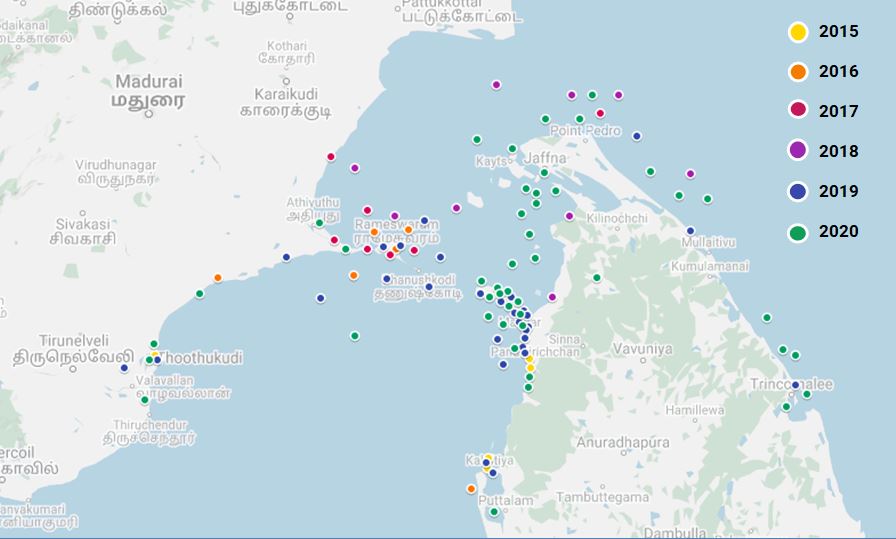by Malaka Rodrigo, Pragati Prava Bai on 7 February 2022
- From 2015 to 2020, authorities in Sri Lanka and India seized nearly 65 metric tons of sea cucumbers worth more than $2.8 million and arrested 502 people in connection with the attempted trafficking.
- The sea cucumber fishery is banned in India and restricted under a licensing system in Sri Lanka, but growing demand for the animals in East Asia has turned the waters between these South Asian countries into a hotspot for the illegal trade.
- The presence of the legal trade in Sri Lanka means Indian fishers can smuggle their catches into the country and launder them into the legal market for export.
- The overharvesting of sea cucumbers has severely depleted their populations; from 21 species of sea cucumber deemed commercially viable for fishing in 2008, there were only nine by 2015, according to surveys.
COLOMBO/MANDAPAM — It was a calm October night over Sri Lanka’s northern seas, the silence broken only by the sound of a rapidly approaching motorboat from India. In Kalpitiya, a town further down the island’s western coast, it rendezvoused with a truck waiting on the beach.
Also waiting there was a Navy patrol team, which seized the illegal consignment of 1,196 kilograms (2,637 pounds) of dried sea cucumbers worth more than 16 million Sri Lankan rupees (nearly $80,000); authorities also arrested two trafficking suspects.
The previous month, on Sept. 19, the Indian Coast Guard made a similar arrest in the waters off Mandapam in Tamil Nadu state. The individuals arrested in that incident were carrying 2 metric tons of sea cucumbers meant to be smuggled by sea into Sri Lanka.
Seizures of illegally harvested sea cucumbers have become increasingly common in the waters between India and Sri Lanka. Between 2015 and 2020, the Sri Lankan Navy and the Indian Coast Guard made 502 arrests and seized nearly 65 metric tons of sea cucumbers worth a combined $2.84 million.

Increase in smuggling
According to data analysis of sea cucumber-related seizures and arrests reported in the media, 2019 and 2020 saw a sharp increase in cases, making the Gulf of Mannar/Palk Bay region between the two countries a global hotspot for sea cucumber smuggling.
Despite their name, sea cucumbers aren’t vegetables; they’re echinoderms, from the same phylum of marine animals that includes starfish and sea urchins, and live on the sandy bottoms of oceans, where they perform the important ecological function of nutrient cycling.
Sea cucumbers aren’t typically eaten in South Asia. Instead, their harvest here is for demand from East Asia, where they go by many names, most often bêche-de-mer, and are considered a delicacy, eaten both fresh or dried, and used in traditional Chinese medicine.
Exports of bêche-de-mer from this region have historically been low, but the trade has grown significantly in recent years as the demand for sea cucumbers has increased. Some species, like the sandfish (Holothuria scabra), sell for around $1,800/kg ($816/lb) while the white teatfish (H. fuscogilva) fetches about $401/kg ($182/lb) due to the high demand, making sea cucumber harvesting a lucrative business.
For the harvesters, the slow-moving sea cucumbers are easy pickings. But this has led to sea cucumber populations becoming overexploited across much of their historical ranges.
In light of this, India banned the sea cucumber fishery in 2001, while Sri Lanka tried to restrict the trade through a system of permits issued for collection, processing, transporting and exporting.

Risking legal loopholes
Given the current market trends, this disparity has allowed Indian fishers to exploit Sri Lanka’s legalized sea cucumber trade. They do this by smuggling their harvest to Sri Lanka to “launder” the Indian sea cucumbers with the legally permitted supplies for export. Sri Lankan fishers also often violate permit conditions by gathering more sea cucumbers than allowed, as a bigger catch means more profit.
There’s also the problem of bottom trawling, which is banned in bothcountries. While 20% of the sea cucumber catch in India is deliberately targeted by fishers, the rest is incidental catch, mainly from bottom trawling. Even then, the incidental catch is hardly ever released back into the sea, said Deepak Bilgi, conservator of forests in Madurai, India.

Indian link
Satish Sundaram, a forest range officer from India’s Mandapam and Ramnathapuram wildlife ranges in the Gulf of Mannar Marine National Park, said that during his five-year tenure until November 2020, he had arrested more than 100 persons in connection with 70 cases of sea cucumber trafficking.
In Sri Lanka, records show that the Navy seized 16,576 kg (36,544 lb) of dried sea cucumbers and 11,840 kg (26,103 lb) of wet sea cucumbers from 2015 to 2021. “While the dried consignments are mostly the smuggled lot, there are also instances that consignments are confiscated because they had sea cucumbers in their possession without a valid permit or in violation of permit conditions,” said Indika de Silva, a spokesman for the Navy.
The biodiversity-rich Gulf of Mannar and Palk Bay areas, the main stretches of water between India and Sri Lanka, are the current hotspot for sea cucumber poaching. But over on the southwestern side of the Indian subcontinent, the Lakshadweep archipelago saw a significant spike in the number of reported smuggling and poaching incidents last year, showing that sea cucumber-related offenses are expanding and spreading to this remote island chain, said Teale Phelps Bondaroff, director of research at OceansAsia, an organization that investigates and marine environmental crimes.
Bondaroff, who analyzed data compiled by the authorities and the media, said there was a sharp increase in cases in 2019 and 2020. “The increase could mean two things: an increase of illegal activity and also the increase of patrolling,” he told Mongabay.
In Sri Lanka, the Navy continues its regular sea patrols and has also strengthened its surveillance along coastal areas where seizures generally occur, according to a Navy spokesman.
Most fishers and the fishing community along the northwestern coastal belt live below the poverty line, and the COVID-19 pandemic only worsened the problem, driving people to look for alternative sources of income.
“But fishers in and around the Gulf of Mannar and the Indian side of Palk Bay are used to collecting and trading sea cucumbers. This requires more study to understand whether the pandemic was a driver of illegal trade of sea cucumber,” said Sajan John, head of the marine unit at the Wildlife Trust of India.

Fishermen’s woes
S. Chinnathambi, coordinator of Sri Lanka’s National Traditional Fishermen Federation, said fishers are constantly being exploited by unscrupulous traders into harvesting high-value threatened species.
“Because sea cucumbers can be sold at a good price, fisherfolk try to harvest more. They will exploit any opportunity,” said Anthony Rajah, a diver from Mannar in the island’s north.
Rajah, who has been harvesting sea cucumbers for decades, told Mongabay that fishers used to be able to collect the animals closer to shore, but now they have to dive deeper and wade into unexplored areas to find them.
“It is not that easy, and we need to put more effort now to collect them compared to then, but still this gives us a better income and I continue to engage in sea cucumber fishery,” Rajah said.
The license system in Sri Lanka has failed to effectively control the ongoing overexploitation of the country’s sea cucumber stocks, with reduced catch sizes reflecting the levels of depletion.

A 2008 study listed 21 commercially viable species for fishing, but by 2015, this had dwindled to just nine. The latter survey also warned of the possible loss of more species, potentially leaving just five as feasible for fishing, according to Ganeshan Nishanthan of the University of Sri Jayewardenepura.
A scientific base for issuing licenses should be adopted based on species and available stocks, said Chamari Dissanayake, also from the University of Sri Jayewardenepura. During her tenure at the National Aquatic Resources Research and Development Agency (NARA), Dissanayake conducted a sea cucumber stock assessment in 2008. That didn’t include the northern seas, given that this part of the country was under rebel control during Sri Lanka’s civil war, which only ended only in 2009.
“So, it is time to have a countrywide stock assessment, before it becomes too late for the species,” Dissanayake told Mongabay.

The government is now promoting sea cucumber farming, which is expected to ease the pressure on wild stocks. While experts have welcomed the move, they caution it must be accompanied by measures to prevent it from becoming yet another way to conceal the illegal trade and export of wild-caught sea cucumbers.
While regulations pertaining to sea cucumber fishery should be reinforced, addressing the smuggling of stocks should be addressed as a bilateral issue with serious repercussions on the conservation of the species in both India and Sri Lanka, Bondaroff said.
This is a high-value trade, so penalties should not be normalized, and immediate action should be taken to protect the region’s sea cucumber populations from overexploitation, he added.
Banner image of processed sea cucumbers, known as bêche de mer, are a popular delicacy in East Asia and an ingredient used in traditional Chinese medicine, making them an expensive commodity. Image courtesy of OceansAsia.


![Coastal resilience reporting grants available [Worldwide]](https://cir.lk/wp-content/uploads/2022/02/boats.jpg)

